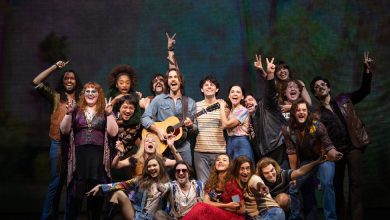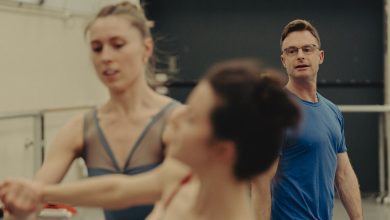Review: In Pam Tanowitz’s ‘Song of Songs’ the Beloved Is Beauty

ANNANDALE-ON-HUDSON, N.Y. — “Kiss me.” No sooner has the biblical Song of Songs begun than the speaker is making a move. For scripture, the poem is pretty salacious, which is one reason it has inspired many interpretations.
The latest is “Song of Songs,” a dance-theater work by the choreographer Pam Tanowitz and the composer David Lang, which had its debut at the Fisher Center at Bard College on Friday. It is a refined, restrained and sometimes breathtakingly beautiful response to the poem. There is no kissing in it, and spirituality is only a suggestion. Instead, the beloved here is beauty.
Tanowitz’s last theatrical production at the Fisher Center, where she is resident choreographer, was the highly acclaimed “Four Quartets.” That work revolved around the recitation of a difficult T.S. Eliot poem. Now the time of singing has come. “Song of Songs” starts with voices in tight harmony: Lang’s 2014 composition “Just (After Song of Songs).”
“Just your voice,” they sing, “just your throat,” listing the lover’s attributes with repeated chords. This alternates with two other motifs, one starting with “And my” (breasts, beloved), the other with “our” (house, laughter). Lang’s composition, adding cello, viola and percussion, is a kind of analysis of the biblical text, pulling phrases that begin with possessive pronouns. The repetition and listing are formal but also appetitive: Just this would be enough, and also this and this. The rhythm is processional, with nearly as much silence as sound, and the voices open and expand on every “our.”
Tanowitz’s choreography treats both the text and the music with similar obliqueness. It begins with a solo, Maile Okamura dancing around the set, which is reminiscent of an elegant hotel lobby: strip curtains outlining an open area with long, low benches and a circular platform. (Production design is credited collectively to Tanowitz, Clifton Taylor and the costume designers Reid Bartelme and Harriet Jung.)
When another dancer arrives (Melissa Toogood), the two don’t behave like lovers, except to circle each other in agitation. At most, they press palms. When more dancers appear, they also touch hands with Okamura, rushing past her, one after the other, expressing avidity through repetition. The feeling is echoed in later sections, as the female dancers are lifted off the platform, one by one, by two men, as over a turnstile.
This is not a dance about a single pair, though at moments it seems like it might be. When the work moves into the first of three new compositions by Lang, a more straightforward setting of the section of the poem starting “I slept but my heart was awake” — the singing throughout, by Sara Brailey, Martha Cluver and Katie Geissinger, is gorgeously clear — Toogood appears to be noticed and then pursued by Zachary Gonder. Together, they gambol like the stags in the poem. But they are not alone for long, as others soon gather to witness.
The emphasis is on the group, the community. The impeccable, unaffected dancers are seven in number, so that even when they all pair off, someone is left out. Toogood, fluttering and falling (as she often does in Tanowitz dances), gives the strongest impression of being “sick with love,” as the poem puts it, but it’s indicative of Tanowitz’s perspective on love here that when Toogood jumps into Gonder’s arms, she nearly jumps through or past them. Unlike the ancient poem, still arrestingly direct, this is a work that dances around sensual love.
That’s part of its beauty. Even when the dancers touch, they seem to maintain a classical distance. They do a lot of watching. Some of their poses could derive from classical art, but more broadly, the work is classical in tone — lucid, legible in the manner of Merce Cunningham. The bursts of difficult, inventive steps and coordinations are also Cunninghamesque. These are balanced by simple folk-dance patterns, and Tanowitz has said her “Song of Songs” is a “Jewish dance,” but it’s Jewish in the sense that Jerome Robbins’s “Dances at a Gathering” is. (Which is to say, not obviously; Robbins was Jewish, as are Tanowitz and Lang.)
As usual, Tanowitz is masterly in her use of space, both invoking and destabilizing the idea of foreground and background, a trio at the rear no more or less important than a solo or duet in front. The curtains (more of which eventually lower to cover the back plane) give her a periphery to activate and also, because of the strips, a permeable border for dancers’ limbs to penetrate.
The closest the dance comes to a kiss is at end of a song listing sensual experiences of the beloved (“I can see you,” “I can taste you”). Toogood and Victor Lozano are face to face, but rather than touching lips, they turn to watch Brian Lawson tilt into a curtain, upheld at an unstable angle by dancers on the other side. Whether that’s an image of human or divine love is left unsettled.
When the dance finally goes into an extended duet sequence, the duets are in relay or “La Ronde” form, one dancer tagging out another. This is the one section without words, without song. It comes as no surprise, after this, that the conclusion is collective, all the dancers drifting as one, posing together on the platform. This response to the poem isn’t a song of the self or a couple. The attitude of Tanowitz and Lang seems to be: “They’re playing our song.”
Song of Songs
Performed July 1-3 at the Fisher Center at Bard College.





